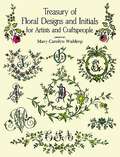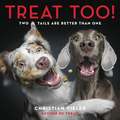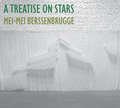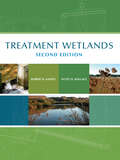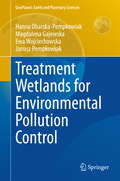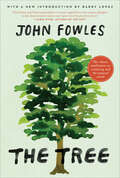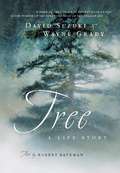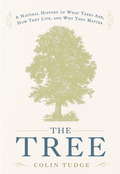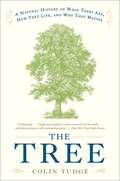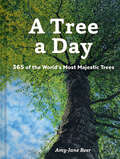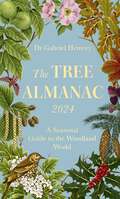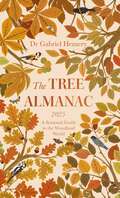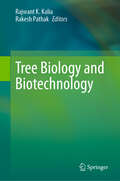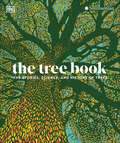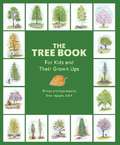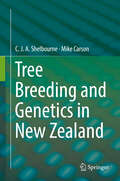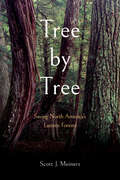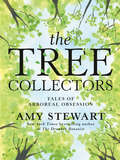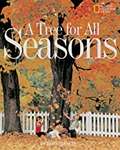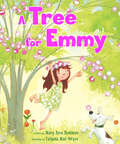- Table View
- List View
Treasury of Floral Designs and Initials for Artists and Craftspeople (Dover Pictorial Archive)
by Mary Carolyn WaldrepYou'll find a thousand different uses for this practical archive of royalty-free designs with a floral theme. It includes over 700 wonderfully graceful and imaginative designs featuring flowers, leaves, and vines in delicate interlacements. Most incorporate elaborately embellished letters, initials, monograms, and names.Needleworkers, fabric painters, and other craftworkers will love browsing through these pages for the perfect design to personalize towels, handkerchiefs, bed linens, clothing, and more. Textile designers, graphic artists, and calligraphers will also find the volume brimming with useful ideas and models for creating rich floral designs, illustrated letters, borders, and frames.
Treat!
by Christian VielerWho's a good dog? In the tradition of bestselling photography books like Underwater Dogs and Shake comes an adorable and hilarious collection of dog photographs capturing our best friends at one of their favorite moments--treat time. Photographer Christian Vieler caught these eager dogs anticipating, catching--some more successfully than others--and enjoying a scrumptious tidbit.From a tenacious terrier to a goofy golden retriever, these often hilarious and surprisingly beautiful photographs capture each dog's unique personality in a way any dog owner will recognize and that all dog lovers will enjoy!
Treat!: DOGS CATCHING TREATS: THE FUNNIEST DOG BOOK OF THE YEAR
by Christian VielerAs seen in the Daily Mail, the Times and the Telegraph Who's a good dog?Photographer Christian Vieler caught these eager dogs anticipating, catching, and enjoying a scrumptious tidbit - some more successfully than others.From a tenacious terrier to a goofy golden retriever, these often hilarious and surprisingly beautiful photographs capture each dog's unique personality in a way any dog owner will recognize and that all dog lovers will enjoy!
Treat Too!: Two Tails Are Better Than One
by Christian VielerFrom the bestselling author of Treat! comes the second ulti-mutt collection of lovable and hilarious photographs of dogs vying for treats -- now with double the pups for even more paw-some fun! Photographer Christian Vieler is an online sensation for pup-arazzi worthy photos of dogs. In Treat! he captured 60 dogs anticipating, catching -- some more successfully than others -- and enjoying a scrumptious snack. In Treat Too, Vieler brings twice the pups, and twice the fun. From a pair of tenacious terriers to a duo of goofy golden retrievers, these hilarious and paws-itively beautiful photographs capture each dog's unique personality in a way any dog owner will recognize and enjoy! Purrfect for the animal lover in your life, these adorable photos will have you rolling over and howling with laughter and love.
A Treatise on Stars
by Mei-Mei BerssenbruggeAn ethereal new collection that is “visceral with intellection” (David Lau) Mei-mei Berssenbrugge’s A Treatise on Stars extends the intensely phenomenological poetics of “The Star Field” in Empathy, which appeared over thirty years ago. The book is structured as a continuous enfolding of poems, each made up of numbered serial parts, their presiding poetic consciousness moving from the desert arroyo of New Mexico to the white-tailed deer of Maine and between conversations with daughter, husband, friends, pets (corn snake and poodle), and a woman, or star-visitor, beneath a tree who calls “any spirit in matter … star-walking.” These are poems of deep listening and patient waiting, open to the channeling of daily experience, to gestalt and angel, dolphins and extraterrestrials. Here, family is a type of constellation and “thought is a form of organized light.” All our senses are activated by Berssenbrugge’s light-absorbing lines, lines that map a geography of interconnected intelligence—interdimensional intelligence—that exists in all sentient objects and sustains us. This is not new age poetry but poetry for a new age, rigorous of thought and grounded in the physical world where “days fill with splendor, and earth offers its pristine beauty to an expanding present.”
Treatment Wetlands
by Scott Wallace Robert H. KadlecCompletely revised and updated, Treatment Wetlands, Second Edition is still the most comprehensive resource available for planning, designing, and operating wetland treatment systems. It provides engineers and scientists with a complete reference source that includes: detailed information on wetland ecology, design for consistent performance, site specific studies, estimated costs, construction guidance and operational control through effective monitoring. Case histories of operational wetland treatment systems illustrate the variety of design approaches presented allowing readers to tailor them to the needs of their projects.
Treatment Wetlands for Environmental Pollution Control
by Hanna Obarska-Pempkowiak Magdalena Gajewska Ewa Wojciechowska Janusz PempkowiakThe aim of this book is to present an overview of the state of the art with regard to the function, application and design of TWSs in order to better protect surface water from contamination. Accordingly, it also presents applications of constructed wetlands with regard to climatic and cultural aspects. The use of artificial and natural treatment wetland systems (TWSs) for wastewater treatment is an approach that has been developed over the last thirty years. Europe is currently home to roughly 10,000 constructed wetland treatment systems (CWTSs), which simulate the aquatic habitat conditions of natural marsh ecosystems; roughly 3,500 systems are in operation in Germany alone. TWSs can also be found in many other European countries, for example 200 - 400 in Denmark, 400 - 600 in Great Britain, and ca. 1,000 in Poland. Most of the existing systems serve as local or individual household treatment systems. CWTSs are easy to operate and do not require specialized maintenance; further, no biological sewage sludge is formed during treatment processes. As TWSs are resistant to fluctuations in hydraulic loads, they are primarily used in rural areas as well as in urbanized areas with dispersed habitats, where conventional sewer systems and central conventional wastewater treatment plants (WWTPs) cannot be applied due to the high costs they would entail. TWSs are usually applied at the 2nd stage of domestic wastewater treatment, after mechanical treatment, and/or at the 3rd stage of treatment in order to ensure purification of effluent from conventional biological reactors and re-naturalization. New applications of TWSs include rainwater treatment as well as industrial and landfill leachate treatment. TWSs are well suited to these fields, as they can potentially remove not only organic matter and nitrogen compounds but also trace metals and traces of persistent organic pollutants and pathogens. Based on the practical experience gathered to date, and on new research regarding the processes and mechanisms of pollutant removal and advances in the systems properties and design, TWSs continue to evolve.
Treaty Implementation for Sustainable Development: NAFTA and Sustainable Development
by Kong, Hoi L. and Wroth, L. Kinvin Hoi L. Kong L. Kinvin WrothThe North American Free Trade Agreement (NAFTA) and its companion agreement, the North American Agreement on Environmental Cooperation (NAAEC), provide important and often underappreciated protection for the environmental laws of the Party states: Canada, Mexico, and the United States. On the twentieth anniversary of NAFTA's ratification, this book assesses the current state of environmental protection under those agreements. Bringing together scholars, practitioners, and regulators from all three Party states, it outlines the scope and process of NAFTA and NAAEC, their impact on specific environmental issues, and paths to reform. It includes analyses of the impact of the agreements on such matters as bioengineered crops in Mexico, assessment of marine environmental effects, potential lessons for China, climate change, and indigenous rights. Together, the chapters of this book represent an important contribution to the global conversation concerning international trade agreements and sustainable development.
The Tree: John Fowles
by John FowlesThe classic meditation on creativity and the natural world“For years I have carried this book. . . with me on travels to reread, ponder, envy. In prose of classic gravity, precision, and delicacy, Fowles addresses matters of final importance.” —W. S. Merwin, Los Angeles Times Book Review“The Tree is the fullest and finest exploration I’ve ever read of how the useless delights to be discovered in nature can ripen into the practice of art.” —Lewis Hyde, author of The GiftFirst published a generation ago, The Tree is renowned English novelist John Fowles's provocative meditation on the connection between the natural world and human creativity, and a powerful argument against taming the wild. In it, Fowles recounts his own childhood in England and describes how he rebelled against his Edwardian father’s obsession with the “quantifiable yield” of well-pruned fruit trees and came to prize instead the messy, purposeless beauty of nature left to its wildest.The Tree is an inspiring, even life-changing book, one that reaffirms our connection to nature and reminds us of the pleasure of getting lost, the merits of having no plan, and the wisdom of following one’s nose wherever it may lead—in life as much as in art.This special 30th anniversary edition includes an introduction by Barry Lopez.
Tree
by David Suzuki Wayne Grady Robert Bateman"Only God can make a tree," wrote Joyce Kilmer in one of the most celebrated of poems. In Tree: A Life Story, authors David Suzuki and Wayne Grady extend that celebration in a "biography" of this extraordinary - and extraordinarily important - organism. A story that spans a millennium and includes a cast of millions but focuses on a single tree, a Douglas fir, Tree describes in poetic detail the organism's modest origins that begin with a dramatic burst of millions of microscopic grains of pollen. The authors recount the amazing characteristics of the species, how they reproduce and how they receive from and offer nourishment to generations of other plants and animals. The tree's pivotal role in making life possible for the creatures around it - including human beings - is lovingly explored. The richly detailed text and Robert Bateman's original art pay tribute to this ubiquitous organism that is too often taken for granted.
The Tree: A Natural History of What Trees Are, How They Live, and Why They Matter
by Colin TudgeThere are redwoods in California that were ancient by the time Columbus first landed, and pines still alive that germinated around the time humans invented writing. There are Douglas firs as tall as skyscrapers, and a banyan tree in Calcutta as big as a football field.From the tallest to the smallest, trees inspire wonder in all of us, and in The Tree, Colin Tudge travels around the world—throughout the United States, the Costa Rican rain forest, Panama and Brazil, India, New Zealand, China, and most of Europe—bringing to life stories and facts about the trees around us: how they grow old, how they eat and reproduce, how they talk to one another (and they do), and why they came to exist in the first place. He considers the pitfalls of being tall; the things that trees produce, from nuts and rubber to wood; and even the complicated debt that we as humans owe them.Tudge takes us to the Amazon in flood, when the water is deep enough to submerge the forest entirely and fish feed on fruit while river dolphins race through the canopy. He explains the “memory” of a tree: how those that have been shaken by wind grow thicker and sturdier, while those attacked by pests grow smaller leaves the following year; and reveals how it is that the same trees found in the United States are also native to China (but not Europe).From tiny saplings to centuries-old redwoods and desert palms, from the backyards of the American heartland to the rain forests of the Amazon and the bamboo forests, Colin Tudge takes the reader on a journey through history and illuminates our ever-present but often ignored companions. A blend of history, science, philosophy, and environmentalism, The Tree is an engaging and elegant look at the life of the tree and what modern research tells us about their future.
The Tree: A Natural History of What Trees Are, How They Live, and Why They Matter
by Colin TudgeFrom tiny saplings to centuries-old redwoods and desert palms, from the backyards of the American heartland to the rain forests of the Amazon and the bamboo forests, Colin Tudge takes the reader on a journey through history and illuminates our ever-present but often ignored companions. A blend of history, science, philosophy, and environmentalism, The Tree is an engaging and elegant look at the life of the tree and what modern research tells us about their future.
A Tree a Day: 365 of the World’s Most Majestic Trees
by Amy-Jane BeerImmerse yourself in the beauty and power of nature with a different tree for every day of the year.Spend every day of the year with one of the world's most fascinating trees. In A Tree a Day seasoned nature writer and journalist Amy-Jane Beer shares 365 majestic and memorable trees from around the world. From the strength of Alder trees to the biology behind the autumn colors of New England; from folkloric medicines in tree sap to Shakespeare's Birnam Wood; from the giant sequoias of California to Klimt's Birch trees—A Tree a Day explores the botany, poetry, folklore, rich history, and natural beauty of trees. Dip in and out or spend each day exploring a new natural wonder. With award-winning photography, works of art, and detailed illustrations on every page, A Tree a Day illuminates the timeless splendor and power of the world's trees.GORGEOUS ILLUSTRATIONS: Each tree is illustrated with a unique work of art—from classical painting to breathtaking photographs.MEDITATIVE START TO EACH DAY: A Tree a Day is a beautiful reminder to pause each day and appreciate the natural world—no matter where you are. Each of the 365 entries offers a seasonal quote, fact, or story about trees to inspire gratitude and wonder.EVERGREEN: Nature lovers will return to this book day after day, year after year—it makes for the perfect bite-sized, bedside reading.AUTHOR EXPERTISE: In addition to being a nature writer for The Guardian, Amy Jane-Beer has written more than 30 books about science and natural history.Perfect for:Tree and Nature Enthusiasts; Gardeners; Hikers, Backpackers, and Campers; Environmentalist; Fans of A Cloud a Day
The Tree Almanac 2024: A Seasonal Guide to the Woodland World
by Dr. Gabriel HemeryA wondrous seasonal journey through Britain and Ireland's trees.Uncover the majesty and minutiae of the arboreal world in forest scientist Dr Gabriel Hemery's illustrated month-by-month guide - including tree folklore and traditions, recipes and crafts, key dates, curiosities to spot, notes on wildlife and scientific marvels from the trees that surround us.From bare branches to budbursts, the first leaves to the first blossom and the great autumn colour-change, the Tree Almanac celebrates with joyous detail all that trees give us - whether ancient or urban - and inspires us to reconnect with nature. Foreword by Tracy Chevalier.
The Tree Almanac 2025: A Seasonal Guide to Understanding the Woodland World
by Dr. Gabriel Hemery'The perfect accompaniment to a year of forest walks' Gardens IllustratedA forest scientist's enlightening journey through Britain and Ireland's trees.Discover the majesty and minutiae of the arboreal world in this joyous month-by-month guide, including woodland folklore and traditions, expert insight on the 'tree of the month', scientific marvels, curiosities to spot, recipes, crafts and things to do.Along with positive environmental actions and fascinating new ways to understand the trees that surround us, this book is an indispensable companion for connecting more deeply with silvan culture.Praise for The Tree Almanac 2024:'I love this book' Lauren Laverne, as featured on BBC Radio 6 Music'A seductive mix of science, history and culture' Tracy Chevalier
The Tree Almanac 2025: A Seasonal Guide to Understanding the Woodland World
by Dr. Gabriel Hemery'The perfect accompaniment to a year of forest walks' Gardens IllustratedA forest scientist's enlightening journey through Britain and Ireland's trees.Discover the majesty and minutiae of the arboreal world in this joyous month-by-month guide, including woodland folklore and traditions, expert insight on the 'tree of the month', scientific marvels, curiosities to spot, recipes, crafts and things to do.Along with positive environmental actions and fascinating new ways to understand the trees that surround us, this book is an indispensable companion for connecting more deeply with silvan culture.Praise for The Tree Almanac 2024:'I love this book' Lauren Laverne, as featured on BBC Radio 6 Music'A seductive mix of science, history and culture' Tracy Chevalier
Tree Biology and Biotechnology
by Rajwant K. Kalia Rakesh PathakThis edited book aims to bring out a comprehensive collection of information on tree biology, breeding, improvement, genetics, and biotechnology. The focus of this book is to address the status of tree biology research through biotechnological, physiological, pathological, and entomological aspects. Trees are dominant and perennial species found in several ecosystems. They are the only piece of infrastructure that gains value over time. Their economic relevance is well known in terms of the production of food, feed, fodder, fuel, timber, and other products. Trees are well-known habitats for different organisms. They also deliver various ecosystem services, including temperature regulation, mitigation of soil erosion, and managing and filtering rainwater. Tree species are versatile and are capable of providing livelihood security to people, besides several other advantages. In the era of high population growth and increasing pressure on agricultural systems, efficient management of tree resources is the need of the time. Therefore, it is essential to understand tree biology, breeding, and improvement. This book comprises information on various aspects of tree breeding, biology, genetics, and research in the improvement of tree species. Applications of tissue culture, biotechnological approaches, tree health management, insect pest management, and nutrient recycling have been covered in the book, along with some chapters on case studies from Rajasthan and Africa. This book is a useful read for agricultural students, researchers, teachers, and professionals interested in the fields of agroforestry, horticulture, silviculture, and tree improvement.
The Tree Book: The Stories, Science, and History of Trees
by DKThe secret world of trees is revealed in this beautiful and absorbing guide to the giants of the plant world. Trees occur naturally throughout the world and have been a part of human history almost as long as humans have existed. Used for shelter, tools, fuel, and food, they also help supply the atmosphere with oxygen and form astonishingly diverse ecosystems, as well as some of the world&’s most beautiful landscapes. Now the intricate world of leafy woodlands and abundant rainforests is revealed in this extensive visual guide to trees, exploring their key scientific traits and their ecological importance, as well as their enduring significance in human history and culture. From ancient oaks and great redwoods to lush banyans and imposing kapoks, The Tree Book reveals the anatomy, behaviors, and beauty of these incredible plants and habitats in detail. Combining natural history and a scientific overview with a wider look at the history, uses, symbolism, and mythology of trees, this book is a new kind of guide to these fascinating organisms.
The Tree Book For Kids and Their Grown-ups
by Gina IngogliaThe birds, the bees, the flowers and the…TREES! How do trees grow? Why do leaves change? What kind of tree is that? The Brooklyn Botanic Garden’s guide answers all kids’ and their parents' tree-related questions in an easy-to-understand way. It features 33 different trees that grow in North America, from rural Georgia to the streets of New York City to the California suburbs.
Tree Breeding and Genetics in New Zealand
by C.J.A. Shelbourne Mike CarsonDothistroma pini changed New Zealand commercial forestry dramatically. Tree breeding became concentrated on a very few species and development of selection methods and breeding strategies changed in response to the new challenges. Tree-Breeding and Genetics in New Zealand provides a critical historical account of the work on provenance research and tree breeding, often with the wisdom of hindsight, and it tracks the development of breeding strategy, especially for P. radiata, Douglas-fir and the most important eucalypt species, E. regnans, E. fastigata and E. nitens. The book is a compendium of abstracts and summaries of all publications and reports on tree improvement in New Zealand since the early 1950s, with added critical comment by the author on much of the work. It is intended for other tree breeders internationally, for interested NZ foresters and for graduate students studying genetics and tree breeding.
Tree by Tree: Saving North America's Eastern Forests
by Scott J. MeinersTree by Tree is a warning and a toolkit for the future of forest recovery. Scott J. Meiners investigates the critical biological threats endangering tree species native to the forests of eastern North America, providing a needed focus on this plight. Meiners suggests that if we are to save our forests, the first step is to recognize the threats in front of us. Meiners focuses on five familiar trees—the American elm, the American chestnut, the eastern hemlock, the white ash, and the sugar maple—and shares why they matter economically, ecologically, and culturally. From outbreaks of Dutch elm disease to infestations of emerald ash borers, Meiners highlights the challenges that have led or will lead to the disappearance of these trees from forests. In doing so, he shows us how diversity loss often disrupts intricately balanced ecosystems and how vital it is that we pay more attention to massive changes in forest composition.With practical steps for the conservation of native tree species, Tree by Tree offers the inspiration and insights we need to begin saving our forests.
The Tree Collectors: Tales of Arboreal Obsession
by Amy StewartFifty vignettes of remarkable people whose lives have been transformed by their obsessive passion for trees—written and charmingly illustrated by the New York Times bestselling author of The Drunken Botanist&“I love everything Amy Stewart has ever created, but this book is my favorite yet. I&’m giving this book to everyone I know. Because it, like its subject, is a gift.&”—Elizabeth Gilbert, author of Eat Pray LoveWhen Amy Stewart discovered a community of tree collectors, she expected to meet horticultural fanatics driven to plant every species of oak or maple. But she also discovered that the urge to collect trees springs from something deeper and more profound: a longing for community, a vision for the future, or a path to healing and reconciliation. In this slyly humorous, informative, often poignant volume, Stewart brings us captivating stories of people who spend their lives in pursuit of rare and wonderful trees and are transformed in the process. Vivian Keh has forged a connection to her Korean elders through her persimmon orchard. The former poet laureate W. S. Merwin planted a tree almost every day for more than three decades, until he had turned a barren estate into a palm sanctuary. And Joe Hamilton cultivates pines on land passed down to him by his once-enslaved great-grandfather, building a legacy for the future.Stewart populates this lively compendium with her own hand-drawn watercolor portraits of these extraordinary people and their trees, interspersed with side trips to investigate famous tree collections, arboreal glossaries, and even tips for &“unauthorized&” forestry. This book is a stunning tribute to a devoted group of nature lovers making their lives—and the world—more beautiful, one tree at a time.
A Tree for All Seasons
by Robin BernardA maple tree goes through many changes over the course of the year. It even produces sap that people turn into maple syrup. This book not only answers questions about how trees work and why seasons change, but it also invites the reader to observe and enjoy nature and its many wonders.
A Tree for Emmy
by Mary Ann RodmanA spirited young girl struggles to get a much-loved mimosa tree for her birthday in this delightful, multigenerational story, ideal for Arbor Day and Earth Day!Emmy loves trees. She loves oak trees with acorns. She loves pine trees with cones, and willow trees with swishy branches. But best of all, Emmy loves the mimosa tree that grows in her grandmother's pasture.So when Emmy decides she wants a mimosa tree of her own for her birthday, she is saddened to learn many garden stores only sell ornamental trees like plum or pear or tulip trees. Emmy is crushed―until she discovers that the answer to her problem is growing right before her eyes!Mary Ann Rodman's joyful story—packed with environmental, independence, and problem-solving themes—will appeal to nature- and tree-lovers as well as those seeking great spring read alouds. Illustrator Tatjana Mai-Wyss's whimsical watercolor and collage artwork captures Emmy's exuberant personality and the story's hopeful ending.
The Tree Forager
by Adele NozedarAimed at tree lovers of all ages, this beautifully illustrated handbook is the first guide to foraging specifically from trees, looking at all the incredible things we can get and make from them, from food and remedies to toys, whistles and ink.Foraging is one of the fastest-growing nature-related pastimes in the UK and US. There are many books about foraging but this is the only one that focuses on what is arguably everyone's favourite plant - trees! It profiles 40 incredible trees from the UK and US - from apple, ash and bay to walnut, willow and yew, gorgeously illustrated with watercolour, pen and ink botanical illustrations. In her humorous, inspiring and warm text, Adele explains how we can forage from our trees, not only for food, but also for home remedies, for ingredients to use in cocktails and ferments, and for materials to make toys, musical instruments and other useful things. Did you know that you can grind acorns into flour to make pancakes, for example, or use oak galls for ink? Or that Willow can be used for weaving; ash, hazel and oak are all good for making charcoal. Packed full of recipes and things to do, there is also a sprinkling of folklore and superstition, as well as helpful recognition tips. Overall it traces the fascinating story of the intimate relationship between humankind and our trees.
